I spoke with photographer Bruce Weber about his exhibition "Bruce Weber: Haiti/Little Haiti," which opens today at the Museum of Contemporary Art, North Miami. In 2003, The Miami Herald published a magazine supplement of Bruce Weber's extraordinary photographs of Miami's Haitian community, a style of street photography that evoked the work of Henri Cartier-Bresson. For this exhibition, a continuation of that project, Weber puts a human face on the consequences of the United State's immigration policy at that time, a policy that resulted in the incarceration of Haitians who had fled their country for a better life. Weber felt compelled to tell the story of the struggle of Haitian immigrants and immersed himself in the Haitian community, a struggle that continued with even greater difficulty this year as the community dealt with the devastating aftermath of the tragic January 2010 earthquake.
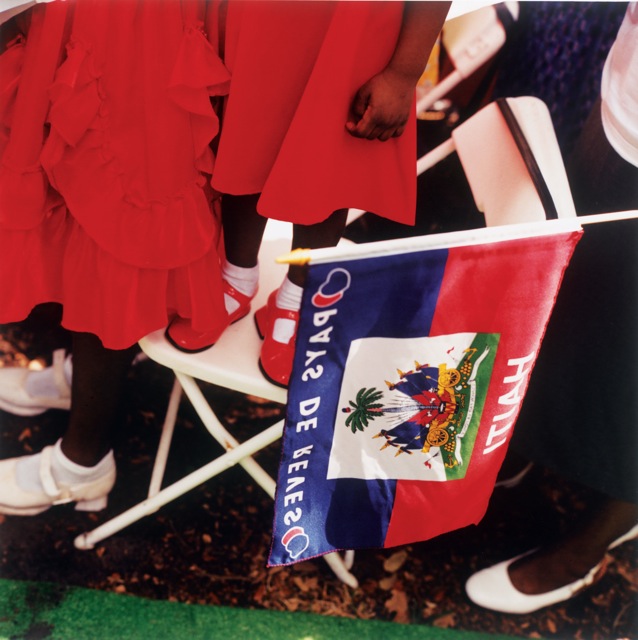
Haitian Flag Day, Little Haiti, Miami, Florida, 2003
Marina Cashdan: Can you talk about the Haitian community in Miami, what (or who) brought you there, and what made you start to take photographs?
Bruce Weber: A lot of these pictures were taken in Little Haiti, a small community in Miami. Even though it's small, it's very vibrant and filled with people who have an incredible history and involvement in the city. By that I mean that they're very active in the church, in the schools, in the cultural aspects, art, theater, and everything that happens in Miami. So they're really involved even though they're from a small community. I happened to go there when I saw a film by Jonathan Demme called The Agronomist...
... about Haitian journalist Jean Dominique [founder of Haiti's only free radio station, who was assassinated in 2000]...
Yeah, I saw this movie at the film festival a couple of years ago, and [the director] Jonathan Demme spoke, and afterward I asked him, 'What can I do?' And he said, 'Well take your camera and go to where a lot of these people are imprisoned and separated from their families. Through pictures and texts, you can let people know that in their own backyard, here in Miami, this is happening.' I was really shocked and outraged just because I couldn't even imagine this happening in America, let alone where I live. So I ended up going to some of the prisons and met a lot of people who came over [to the US from Haiti] and were separated from their mother or father, or parents separated from their children. And then I went to a church and the Father there announced that we were there working on a piece for the Miami Herald and it just kind of grew from that. And through that early work I discovered and really got to know an amazing group of people.
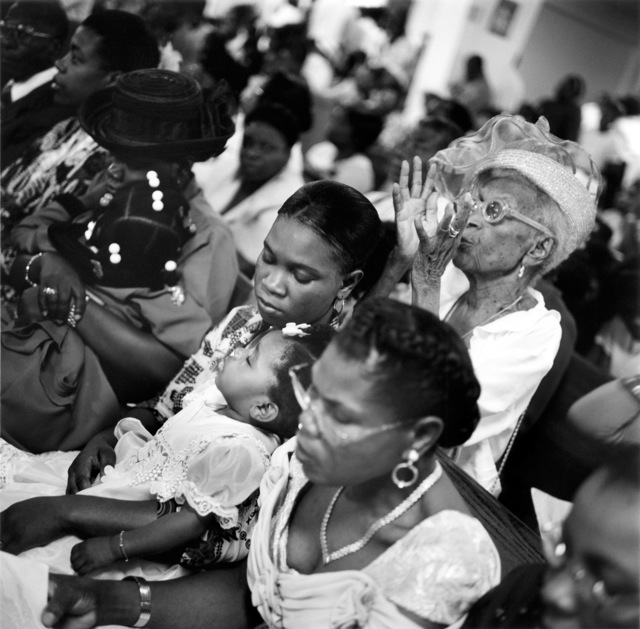
Sunday Mass, Notre Dame D'Haiti Catholic Church, Little Haiti, Miami, Florida 2003
Weber was given access to photograph in this church (in many ways the center of the Haitian community in Miami) with the help first of Father Gerard Darbouze and more recently Father Reginald Jean-Marie.
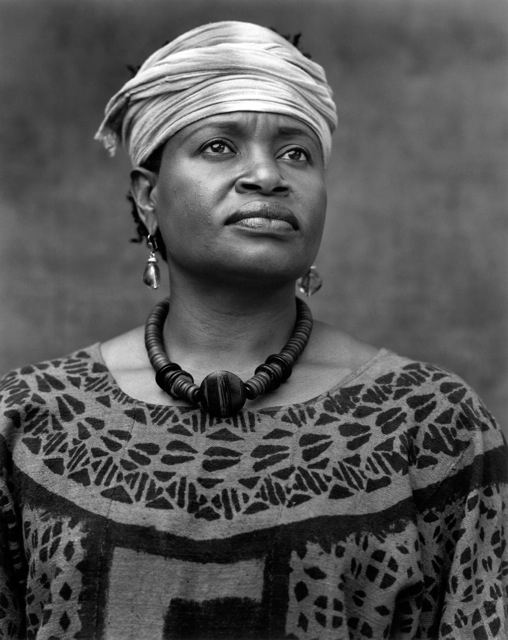
Marleine Bastien, executive director of FANM, Miami, Florida 2003
Bastien has been an instrumental liaison to the Haitian community for Weber throughout this project. She is the executive direction of the organization Haitian Women of Miami and recently ran for Congress.
And were people automatically comfortable with the camera, I mean, were people open from the get-go, or did it take quite a bit of time for them to get comfortable with you?
Well, we had a friend of ours Marleine Bastien who recently ran for Congress. She's quite well known in the community and so she was with us a lot at the beginning, and I really feel that because of that they trusted us a little more. You know the Haitian people are treated so badly all over the world that there is no reason for them to trust us at all. But somehow they did and they were very open. That trust they gave us was so fragile and so heartwarming that we just felt like it pushed us onto the next subject, and the next subject, and the next.
Have you been down to Haiti since the earthquake in January?
BW: I went to Haiti a long time ago. I haven't gone since the earthquake. I was going to go about a year ago to visit a friend of mine, Paul Farmer, co-founder of [the organization] Partners in Health. He has a clinic up in the mountains. And at the time when I was going, he said, 'Don't come, this is too dangerous.' And then the earthquake happened. And I was so involved in the community in Miami and the people that came over after the earthquake that I just didn't want to lose that.
After the earthquake, you must have been concerned about whether these people that you had been documenting had family still there. I can imagine that you developed a relationship with them outside of photographing them?
Well, with some of them yes. I mean some of them I would see in church. I went to church a lot for a Jewish boy [chuckles] and it was very interesting because I would see people who I photographed a year ago or just a couple of weeks ago. And conversely I got to see people on the streets that I met in church or I've gone to their homes to photograph them. They were really involved. I also got to become good friends with lot of the men and women from the Catholic charities who act as pro-bono lawyers for a lot of the Haitian people. Their stories were very compelling and really helped us find people to photograph. And sometimes you felt like you were in a novel or something, like you were mysteriously placed and you never knew how you got there, you know what I mean?
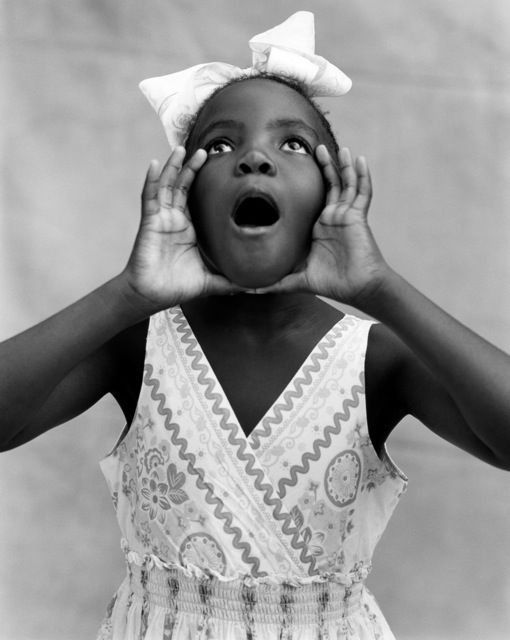
Keren Love Francois, Golden Beach, Florida 2010

Ginette Eugene, Gina Eugene and Youri Drouinead, Golden Beach, Florida 2010
Ginette and Gina are nurses who run the organization Good Samaritan For A Better Life. Together with the IKF's Wonderfund, a program of the Jackson Memorial Foundation, they raise money and make arrangements for many Haitian children to come to Miami to receive critical medical care. Gina was in Port-Au-Prince when the earthquake struck this year. Youri was a boy who had lost his legs prior to the earthquake who they arranged to bring to the United States after the disaster
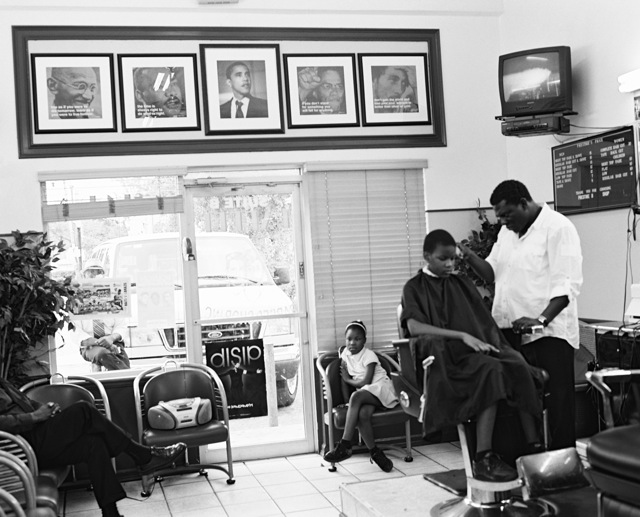
Prestige Barbershop, Miami, Florida 2010
I can understand that. I work a lot with artists and go to their studios and often one artist will then recommend another artist to visit and then that artist might recommend another and so on; it's a matrix of people that exist that you end up weaving your way into it almost unexpectedly. On another note, will your two films Liberty City is My Paris and A Letter to True (both filmed in Miami) be showing as part of the MOCA show as well?
MOCA will be showing the films during the run of the exhibition but it's not going to be in the exhibition.
I wonder if there's some sort of common denominator in all of the photographs, whether they're street photography, or documentary photography, or things that are set in the studio that are quite highly set up. From your perspective, what's the common denominator in all of your photographs?
Well you know, photography is kind of a hard thing to talk about in that way, at least for me, because almost everyday I'm doing something different. I like to start out each day from the beginning. I'm always learning things. If I had to say one thing, it's to have an experience and learn something, which I hope comes through in all of my pictures.
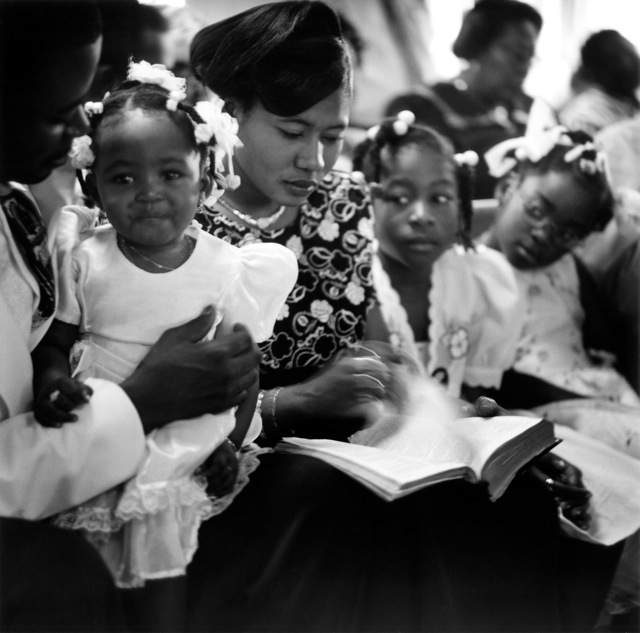
Sunday Mass, Notre Dame D'Haiti Catholic Church, Miami, Florida 2003

Leonard Mouge, Miami, Florida 2003
Leonard had been detained for three months before release.
And you shoot all of your photographs on film [as opposed to digital]?
Yeah I'm old school, sorry (laughs).
No apologies needed. I appreciate that you still use film. In fact my husband is a photographer and he prefers to shoot on film. He says that it's a very different process from digital -- that you have to be more thoughtful when shooting on film because you go at a slower pace whereas digital is so fast.
Well, I think so. The actress Jessica Lange takes really great photographs, and Jessica and I were talking about [shooting on film] and she said something really great, she said, 'You know, the great thing about using film is it can be a more intimate experience.' It's just because you're maybe not shooting as fast ... It's also easier to mess up, which is good, because then you can have a mistake which surprises you and maybe makes you think about something else.
Can you tell me a littler bit about your relationship to Miami, when you first started living there, what drew you to the city, and things that, for instance, someone like me who really only goes to Miami once or twice a year maybe, might not know about the city?
I have this conversation with a lot of people and they always ask me that question, and I tell them that for me, Miami is really not South Beach. Miami is the communities: the Cuban community, the Haitian community, the Puerto Rican community -- the very international feeling of these communities. It was this that attracted me to Miami, aside from the ocean and the parks. And I like that it's still one of the few places in America that has that exotic-ness about it, where you can go to let's say the Dominican section of the city where and old man and kids are playing baseball. Or if you go to the Puerto Rican section, it's a whole different scene. And there are so many big athletes who went to school around these areas who have done well in the Olympics and so on. So, I kind of like what these communities contribute to the city as a whole. That was really my first feeling about Miami. I liked that it was different. I liked that when I first went down there, even in South Beach, you'd see elderly people with skateboards and the eclectic mixture. It's a little hard to find that now [in South Beach], so that's why I go to these other communities, and go to their restaurants and stores...
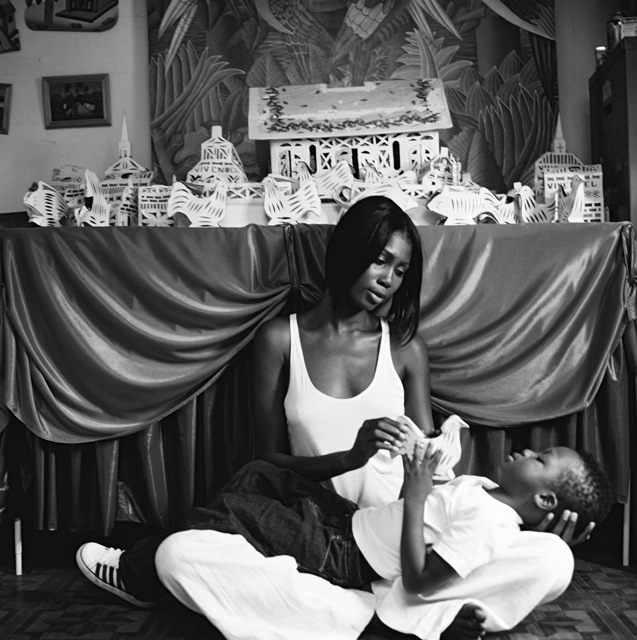
Kiki Barthelemy and her son, Shamar Key, Little Haiti, Miami, Flroida 2010
Kiki is a model and community activist. Weber has photographed her on several occasions, most recently for a Bobbi Brown project.
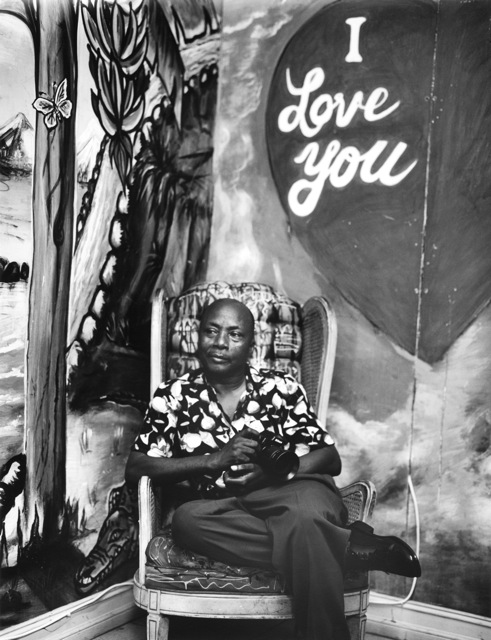
Merus Benoit, photographer, Little Haiti, Miami, Florida 2010
Merus is a photographer in Miami and owns a studio.
How long have you been living in Miami?
I've been living there for 12 years.
A lot of readers will be going down to Miami in the next few weeks for Art Basel Miami Beach. Do you have any recommendations on places they should visit that you feel represent your experience in the city?
Hmm, let's see. Ok--I'd go to the Black History T-Shirt store...
You featured that store in your film Liberty City is My Paris. It looks fascinating.
It's great to hang out there, and just check it out. Let's see ... there's also a restaurant that I went to with Iggy Pop, I'm trying to remember what it's called, it's a very famous barbecue place ... it's in an amazing building... And there are some really good alternative galleries. I don't know the names of them right now but if it helps there's a girl who has this great gallery in a little pool house and she doesn't have any water in her pool [laughs] and she puts paintings in there. It's very interesting. And there are a whole bunch of kids who are doing street art. I think you have to get a car and drive around [Miami].
Yeah, I think that's the mistake I always make, because when I go down there I don't usually rent a car ...
Oh, no no. You have to rent a car. That will be really fun for you. You'll really see the place much more.
That's valuable advice. I'll definitely do that this year. Thanks so much for speaking with me. I hope to see you in Miami in December.
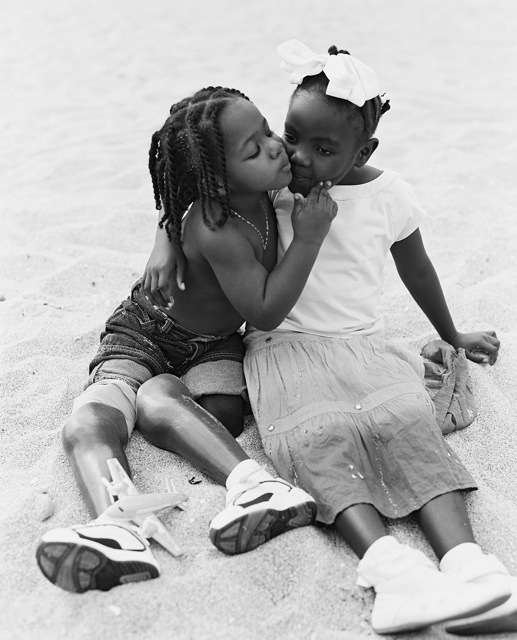
Youri Drouinead and Keren Love Francois, Golden Beach, Florida 2010

Little Haiti, Miami, Florida 2003
Bruce Weber: Haiti/Little Haiti
Knight Exhibition Series
November 18, 2010 to February 13, 2011
A catalogue with essays by Bonnie Clearwater and writers active in the Haitian community will accompany the exhibition. Bruce Weber is organized by the Museum of Contemporary Art, North Miami and is curated by MOCA Executive Director and Chief Curator Bonnie Clearwater. The exhibition was made possible with major support from the John S. and James L. Knight Foundation.